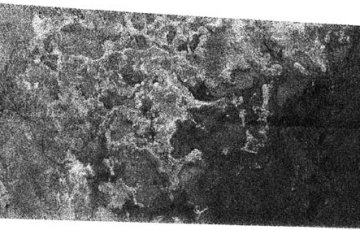Shoreline for Titan?
New radar images of Saturn’s smog-shrouded moon Titan show signs of a shoreline cutting across the moon’s southern hemisphere. Such a shoreline might have been sculpted by liquid methane. Researchers have long speculated that methane, abundant in Titan’s thick atmosphere and recently found in frozen form on its surface, rains down on the moon. Titan is too cold for water to be present as a liquid.

High prevalence of liquid methane would support the notion that Titan is a chemical cousin of the early Earth, and contains a hydrocarbon brew much like the one from which life emerged on our planet.
The apparent shoreline shown in the radar images, taken by the Cassini spacecraft on Sept. 7, during its eighth flyby of Titan, divides a bright region from a dark one. Radar-bright areas on moons and planets tend to be rough, while radar-dark areas are smooth.
The dark region is “where liquid or a wet surface has most likely been present, now or in the recent past,” says Cassini scientist Steven Wall of NASA’s Jet Propulsion Laboratory in Pasadena, Calif.
A shoreline would remain intact even after a liquid has receded, notes team member Jonathan Lunine of the University of Arizona in Tucson. However, the darkest, smoothest parts of the images could indicate pools of liquid hydrocarbons now present on the moon, he adds.
In the bright region, a network of channels—some of them 100 kilometers long—may indicate where liquid hydrocarbons have cut into Titan’s icy crust.







